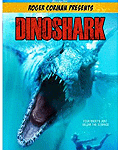The Corman Touch: Part II

"Contrary to one's immediate reaction, there are deep social mores beneath those Lycra-cradled buttocks."
When his first and only genuine effort to make social drama, a superb adaptation of Charles’ Beaumont’s novel The Intruder (1962), flopped and lost money, producer / director Roger Corman gave up on so-called message films, and stuck with bug-eyed monsters, Poe adaptation, and eventually became the premiere producer of B-movies.
Now in his eighties, Corman’s producing credits span more than 350 titles, which is frankly insane, yet he remains the same affable yet frugal producer beloved by former protégés like Joe Dante.
Whether it was the 1978 Piranha, the 1995 Piranha (aka Piranhas), or the recent Dinoshark (2009) and Sharktopus [M] (2010) productions, Corman served as mentor to the craft of ‘efficient’ filmmaking. None of the films qualify as art, yet their makers went from editors, production managers, and special effects whizzes to directors – something typical of the old studio system, but largely absent today except with producers who enjoy productive associations with major studios.
That Corman continues to make movies is a wonder simply because he’s weathered the demise of drive-in theatres, the death of major indie outfits like AIP and Avco Embassy, his own releasing firms New World and Concord, and the lack of theatrical releases.
Around the nineties, Corman settled into making exploitation fodder for cable TV, which allowed more gore and boobery, but mandated formulaic product. The disposable nature had to be offset by brand recognition, so Corman reached back into his back catalogue and remade A Bucket of Blood (1995), Piranha (1995), and The Wasp Woman (1995).
He also riffed on the 1958 Woolner production, Attack of the 50 Foot Woman, making Attack of the 60 Foot Centerfolds (1995), and during the eighties he also remade Not of This Earth (1988) and Masque of the Red Death (1989).
His nineties remakes are more interesting because of the casting and virtual scene-for-scene retention of the original scripts. Piranha doesn’t need to exist, but has a minor curiosity value in seeing scenes from the ’78 Dante version replayed with slight tweaks, new faces, and the integration of effects footage from the original film.
Again, it has no reason to exist, but it made for an easy cable TV sale, filled the rental shelves, and if examined with critical eyes, shows the stylistic shifts within a 16 year period – namely faster editing, snappier dialogue, and a shorter running time for a 90 minute time slot.
 Dinoshark [M], available in a swanky Blu-ray edition from Anchor Bay, is similarly brief, but unlike its unofficial sequel, Sharktopus, it takes itself too seriously and lacks the necessary fromage factor that was effectively maintained in Piranha [M] (1995). Corman’s millennium era product is sometimes amusing, but like all good B-level cheese, it requires a special blend of the right elements (Eric Roberts always helps), and luck.
Dinoshark [M], available in a swanky Blu-ray edition from Anchor Bay, is similarly brief, but unlike its unofficial sequel, Sharktopus, it takes itself too seriously and lacks the necessary fromage factor that was effectively maintained in Piranha [M] (1995). Corman’s millennium era product is sometimes amusing, but like all good B-level cheese, it requires a special blend of the right elements (Eric Roberts always helps), and luck.
I’ll have reviews of the BBC’s Human Planet (Warner Home Video) and a pair of Mimsy Farmer gialli up shortly.
This past weekend was devoted to Doors Open Toronto, and between film and soundtrack reviews I’ll interpolate a few posts and photo essays on some of Toronto’s more intriguing buildings I managed to visit, some tethered to related docs.
.
.
Mark R. Hasan, Editor
KQEK.com
Category: Uncategorized

















Connect